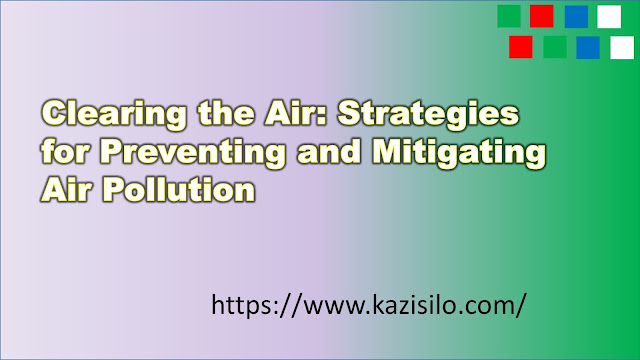Air pollution is a serious issue that affects many parts of the world. It poses a threat to public health, causes environmental damage, and contributes to climate change. Air pollution can come from many sources, including industrial emissions, vehicle exhaust, and burning fossil fuels. In this article, we will explore the causes and effects of air pollution, and discuss strategies for preventing and mitigating this problem.
 |
Causes of Air Pollution
Air pollution can be caused by both human activities and natural sources. Some of the major sources of air pollution include:
1. Industrial Emissions: Industries such as manufacturing, construction, and mining produce large amounts of pollutants such as sulfur dioxide, nitrogen oxide, and carbon monoxide.
2. Transportation: Vehicles such as cars, trucks, and buses emit pollutants such as carbon monoxide, nitrogen oxide, and particulate matter.
3. Fossil Fuel Burning: Burning of fossil fuels such as coal, oil, and gas releases large amounts of carbon dioxide, sulfur dioxide, and nitrogen oxide into the atmosphere.
4. Agricultural Activities: Agricultural activities such as livestock farming and crop burning also contribute to air pollution.
Effects of Air Pollution
Air pollution has many negative effects on human health and the environment. Some of the major effects of air pollution include:
1. Respiratory Problems: Air pollution can cause respiratory problems such as asthma, bronchitis, and lung cancer.
2. Cardiovascular Problems: Air pollution can also lead to cardiovascular problems such as heart disease and stroke.
3. Environmental Damage: Air pollution can harm plants and animals, and cause damage to ecosystems.
4. Climate Change: Air pollution is a major contributor to climate change, which is causing global warming and other environmental problems.
Preventing and Mitigating Air Pollution
There are several strategies that can be used to prevent and mitigate air pollution. Some of these strategies include:
1. Use of Clean Energy Sources: The use of clean energy sources such as wind, solar, and hydroelectric power can help to reduce air pollution.
2. Energy Efficiency: Improving energy efficiency can help to reduce the amount of energy needed, which in turn reduces air pollution.
3. Public Transportation: Encouraging the use of public transportation such as buses and trains can help to reduce vehicle emissions.
4. Alternative Fuel Vehicles: Promoting the use of alternative fuel vehicles such as electric cars can help to reduce vehicle emissions.
5. Regulations and Policies: Governments can implement regulations and policies to limit emissions from industries and vehicles.
6. Awareness and Education: Raising awareness and educating the public about the effects of air pollution and how to prevent it can help to reduce air pollution.
Conclusion
Air pollution is a serious issue that affects many parts of the world. It poses a threat to public health, causes environmental damage, and contributes to climate change. However, there are many strategies that can be used to prevent and mitigate air pollution. The use of clean energy sources, energy efficiency, public transportation, alternative fuel vehicles, regulations and policies, and awareness and education can all help to reduce air pollution. It is important that we take action to prevent and mitigate air pollution so that we can protect our health and the environment.
কোন মন্তব্য নেই:
একটি মন্তব্য পোস্ট করুন